CIMA - C1 Fundamentals of Management Accounting
Подождите немного. Документ загружается.

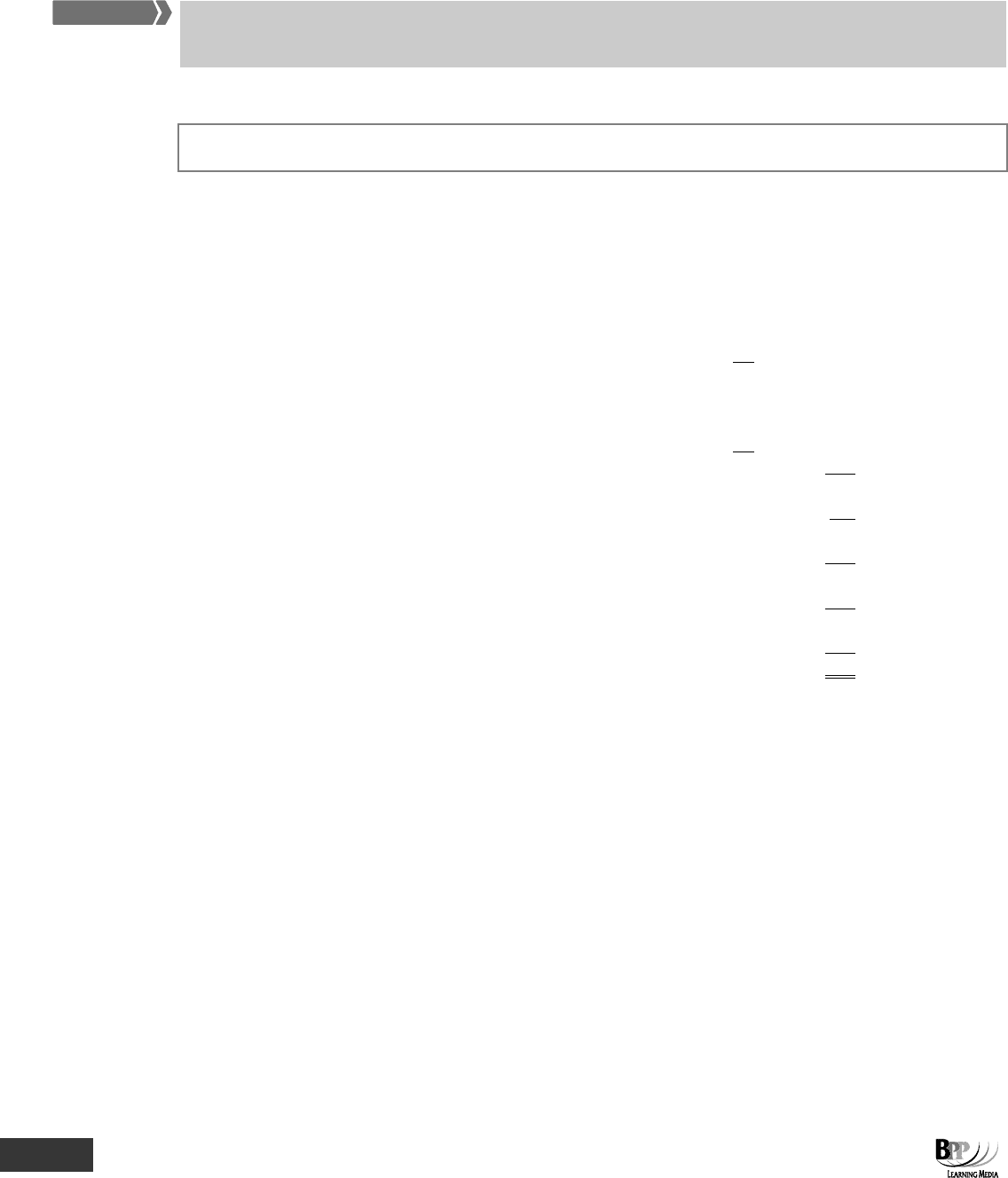
150
7: Standard costing ⏐ Part B Standard costing
1 Standard costing
Standard costing is the preparation of standard costs to value inventories/cost products and/or to use in variance
analysis, a key management control tool.
1.1 Standard cost
A standard cost is a 'planned unit cost of a product, component or service'. CIMA Official Terminology
A standard cost card shows full details of the standard cost of each product.
The standard variable cost of product 1234 is set out below.
STANDARD COST CARD - PRODUCT 1234
$
$
Direct materials
Material X – 3 kg at $4 per kg
12
Material Y – 9 litres at $2 per litre
18
30
Direct labour
Grade A – 6 hours at $7 per hour
42
Grade B – 8 hours at $8 per hour
64
106
Standard direct cost
136
Variable production overhead – 14 hours at $0.50 per hour
7
Standard variable cost of production
143
Fixed production overhead – 14 hours at $4.50 per hour
63
Standard full production cost
206
Administration and marketing overhead
15
Standard cost of sale
221
Standard profit
20
Standard sales price
241
Notice how the total standard cost is built up from standards for each cost element: standard quantities of materials at
standard prices, standard quantities of labour time at standard rates and so on. It is therefore determined by
management's estimates of the following.
• The expected prices of materials, labour and expenses
• Efficiency levels in the use of materials and labour
• Budgeted overhead costs and budgeted volumes of activity
1.2 The uses of standard costing
Standard costing has a variety of uses but its two principal ones are as follows.
(a) To value inventories and cost production for cost accounting purposes. It is an alternative method of
valuation to methods like FIFO and LIFO which we looked at in Chapter 5.
(b) To act as a control device by establishing standards (planned costs), highlighting (via variance analysis
which we will cover in the next chapter) activities that are not conforming to plan and thus alerting
management to areas which may be out of control and in need of corrective action.
FA
S
T F
O
RWAR
D
Key term
171433 www.ebooks2000.blogspot.com
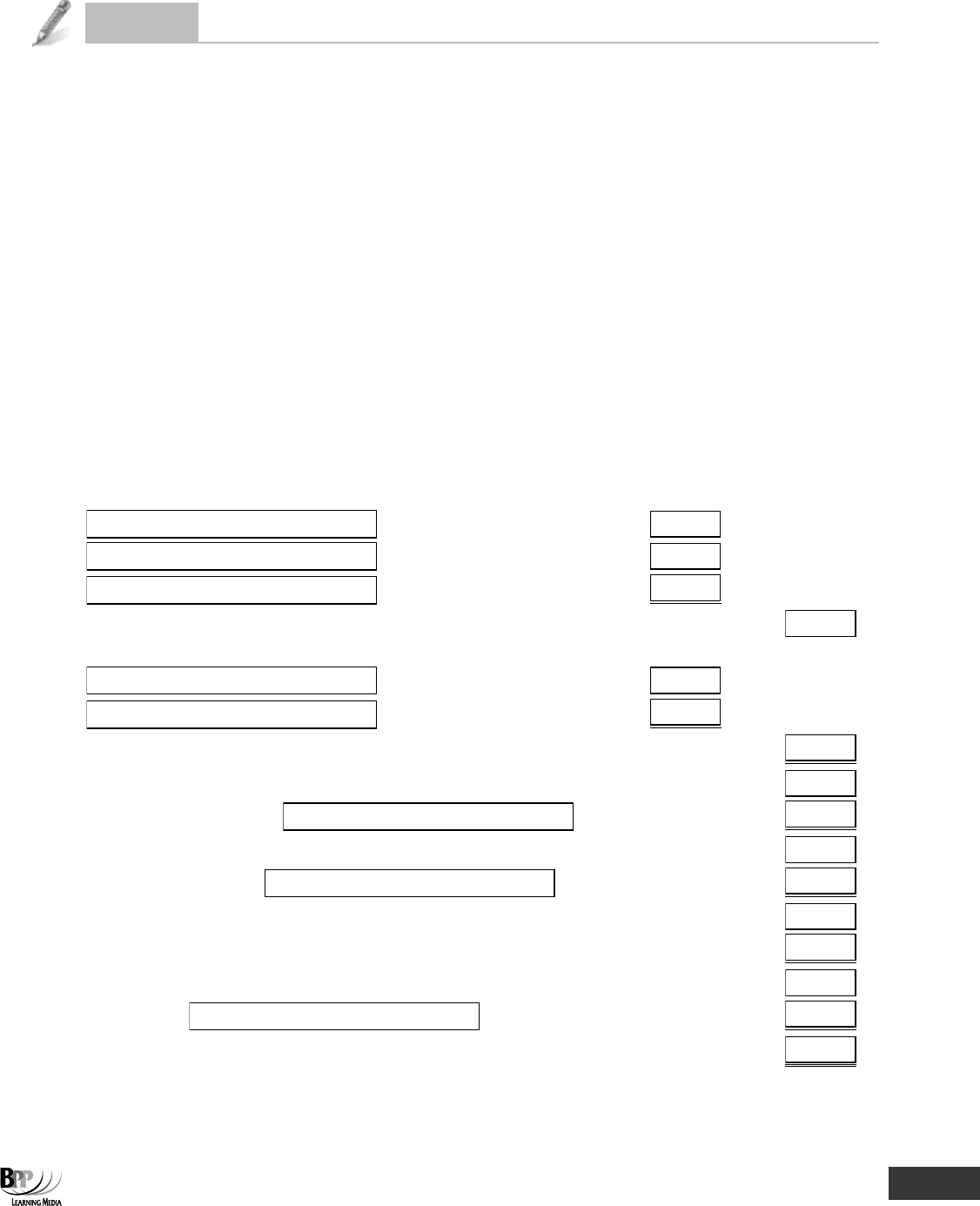
Part B Standard costing ⏐ 7: Standard costing
151
Question
Standard cost card
B Company makes one product, the J. Two types of labour are involved in the preparation of a J, skilled and semi-skilled.
Skilled labour is paid $10 per hour and semi-skilled $5 per hour. Twice as many skilled labour hours as semi-skilled
labour hours are needed to produce a J, four semi-skilled labour hours being needed.
A J is made up of three different direct materials. Seven kilograms of direct material A, four litres of direct material B and
three metres of direct material C are needed. Direct material A costs $1 per kilogram, direct material B $2 per litre and
direct material C $3 per metre.
Variable production overheads are incurred at B Company at the rate of $2.50 per direct labour (skilled) hour.
A system of absorption costing is in operation at B Company. The basis of absorption is direct labour (skilled) hours. For
the forthcoming accounting period, budgeted fixed production overheads are $250,000 and budgeted production of the J
is 5,000 units.
Administration, selling and distribution overheads are added to products at the rate of $10 per unit.
A mark-up of 25% is made on the J.
Required
Using the above information complete the standard cost card below for the J.
STANDARD COST CARD – PRODUCT J
$ $
Direct materials
Direct labour
Standard direct cost
Variable production overhead
Standard variable cost of production
Fixed production overhead
Standard full production cost
Administration, selling and distribution overhead
Standard cost of sale
Standard profit
Standard sales price
172433 www.ebooks2000.blogspot.com
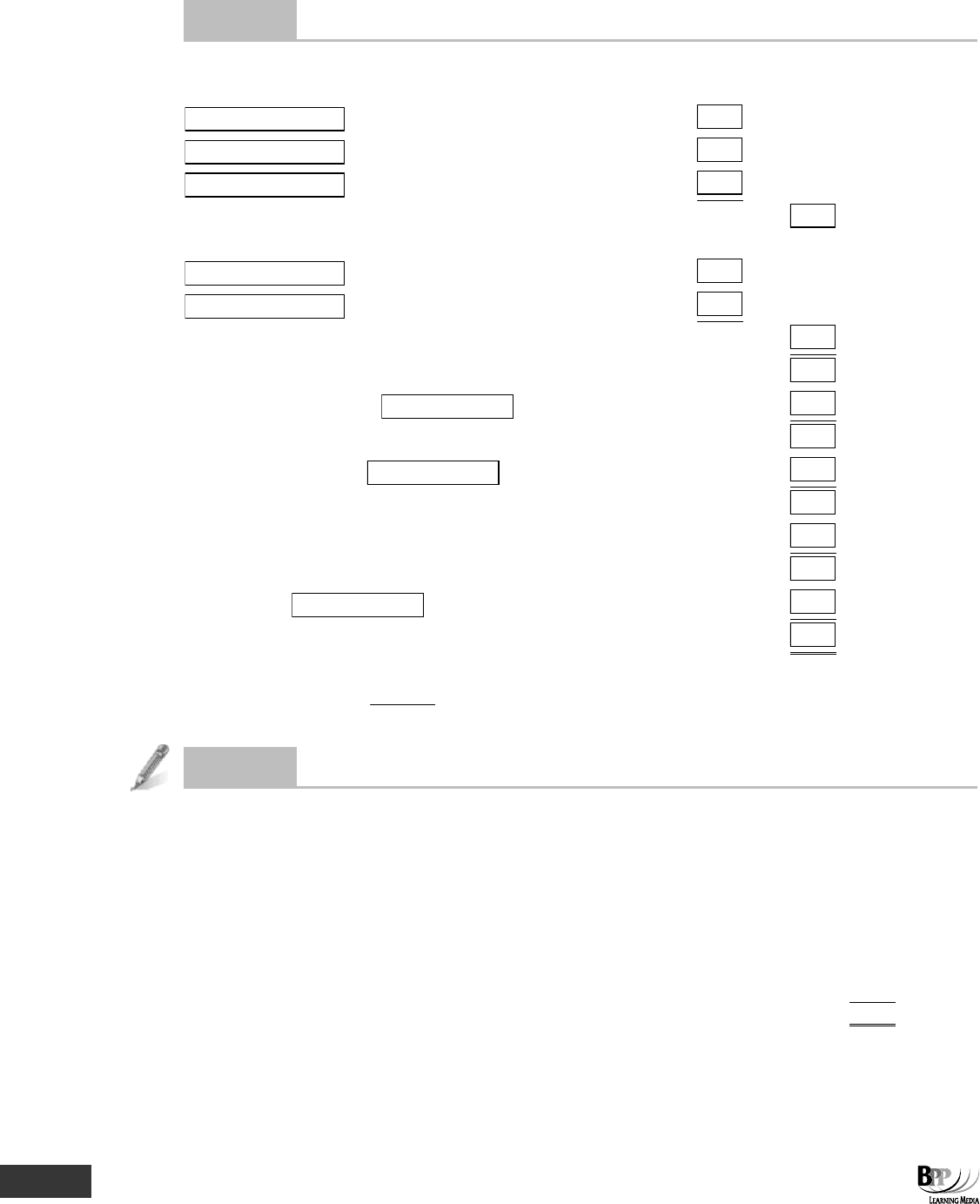
152
7: Standard costing ⏐ Part B Standard costing
Answer
STANDARD COST CARD - PRODUCT J
Direct materials
$
$
A 7 kgs × $1
7
B 4 litres × $2
8
C 3m × $3
9
24
Direct labour
Skilled – 8 × $10
80
Semi-skilled – 4 × $5
20
100
Standard direct cost
124
Variable production overhead
8 × $2.50
20
Standard variable cost of production
144
Fixed production overhead
8 × $6.25 (W)
50
Standard full production cost
194
Administration, selling and distribution overhead
10
Standard cost of sale
204
Standard profit
25% × 204
51
Standard sales price
255
Working
Overhead absorption rate =
8 5,000
$250,000
×
= $6.25 per skilled labour hour
Question
Profit calculations
Product P has the following standard cost card based on production and sales levels of 15,000 units.
$
Production cost
Variable
32.00
Fixed
45.50
Selling cost
Variable
7.50
Fixed
29.00
Profit
5.00
Selling price
119.00
In the month of June, production was 16,000 units and sales were 15,000 units. Assuming all other factors remained the
same, what was the profit for June?
173433 www.ebooks2000.blogspot.com
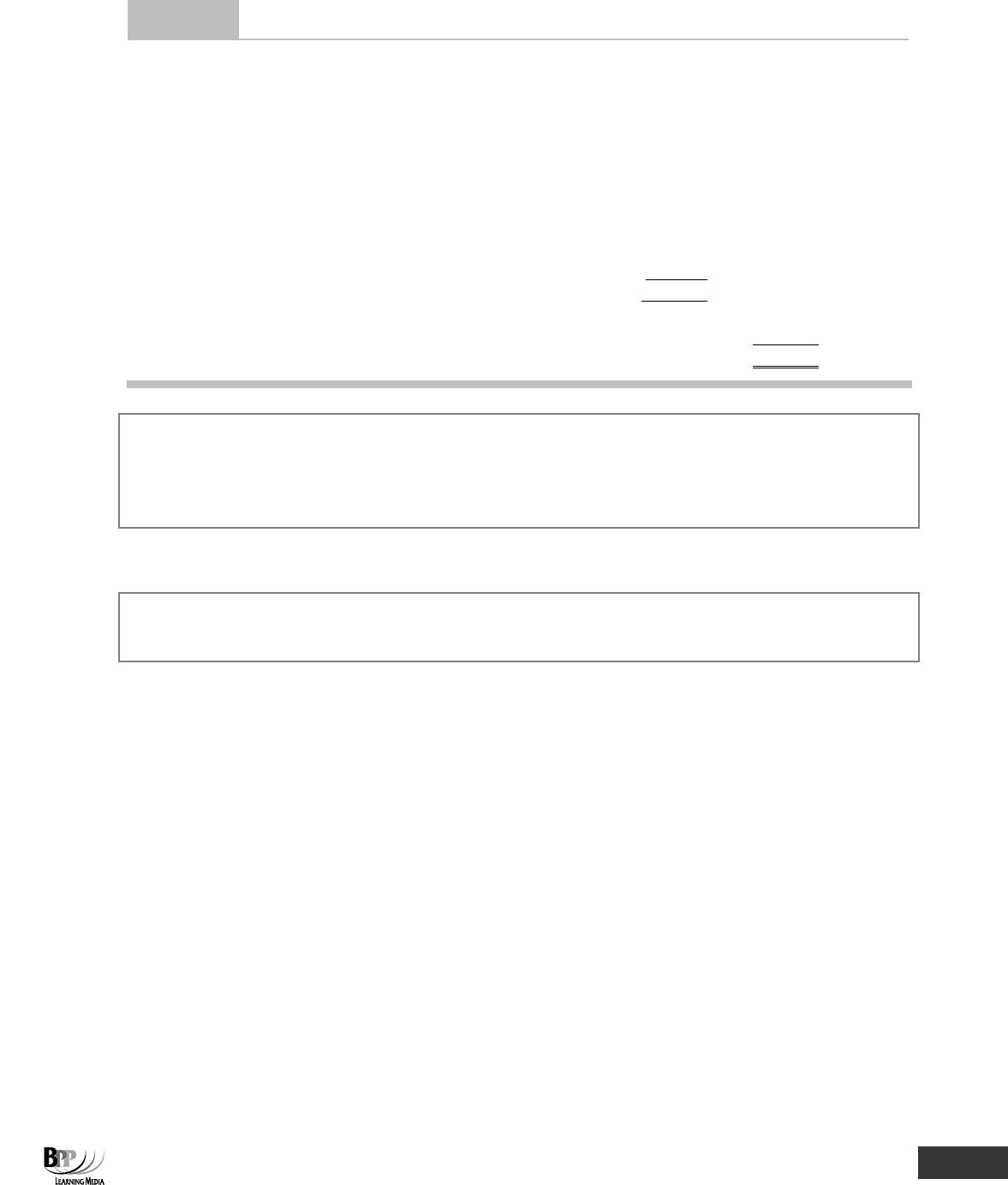
Part B Standard costing ⏐ 7: Standard costing
153
Answer
$120,500
$
Revenue
15,000 × $119.00
1,785,000
Cost of sales
Fixed production cost
15,000 × $45.50
682,500
Fixed selling cost
15,000 × $29.00
435,000
Variable production cost
16,000 × $32.00
512,000
Variable selling cost
15,000 × $7.50
112,500
1,742,000
Less closing inventory
1,000 × ($32 + $45.50)
77,500
1,664,500
Profit
120,500
You may have struggled with the question above. It can be confusing when you first see it, but in standard costing, fixed
costs are often given as a value per unit. This doesn't mean that the cost should be multiplied by the actual number of
units. To obtain the value for the total fixed cost you must multiply the fixed cost per unit by the budgeted number of
units.
1.3 Standard costing as a control technique
Standard costing is a 'control technique that reports variances by comparing actual costs to pre-set standards so
facilitating action through management by exception'. CIMA Official Terminology
Standard costing (for control) therefore involves the following.
• The establishment of predetermined estimates of the costs of products or services
• The collection of actual costs
• The comparison of the actual costs with the predetermined estimates.
The predetermined costs are known as standard costs and the difference between standard and actual cost is known as
a variance. The process by which the total difference between standard and actual results is analysed is known as
variance analysis.
1.4 Historical costs versus standard costs
A focus on the future is one of the principal differences between the work of the cost and management accountant and
the work of the financial accountant.
(a) Financial accountants are concerned with ensuring that the accounting records show a true and fair view
of the organisation’s operations over the accounting period (say 12 months).
(b) Cost and management accountants, on the other hand, are not so worried about the absolute validity,
accuracy and verifiability of past events and transactions. Given their focus on planning, control and
decision making they are more concerned with what is likely to happen in the future.
Key term
Attention!
174433 www.ebooks2000.blogspot.com
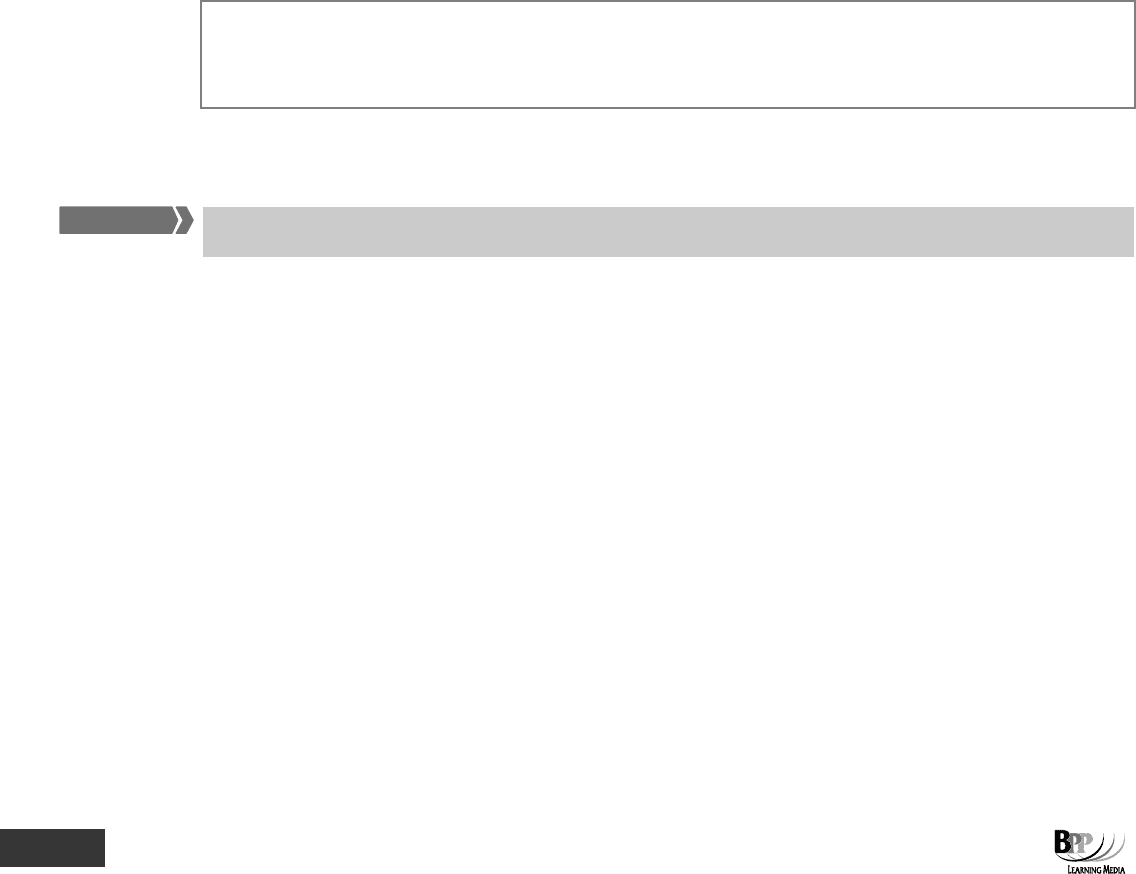
154
7: Standard costing ⏐ Part B Standard costing
That’s not to say that cost and management accounting is not concerned with the past. In the final part of this text we
will look in depth at the basic role of costing in accumulating, classifying, recording and ascertaining both historical
unit costs and historical total costs of operations. And it is only after basic cost accounting methods and processes
have provided information about the historical costs of running an organisation that, in essence, the cost and
management accounting role of providing information for planning, control and decision making can begin.
Standard costing is an integral part of an organisation’s system of planning and control and is based on standard costs
that are established in advance, before events and transactions occur. They represent what should happen rather than
what has happened.
1.5 Standard costing and management by exception
Standard costs, when established, are average expected unit costs. Because they are only averages and not a rigid
specification, actual results will vary to some extent above or below the average. Standard costs can therefore be
viewed as benchmarks for comparison purposes, and variances (the differences between standard costs and actual
costs) should only be reported and investigated if there is a significant difference between actual and standard. The
problem is in deciding whether a variation from standard should be considered significant and worthy of investigation.
Tolerance limits can be set and only variances that exceed such limits would require investigation.
Standard costing therefore enables the principle of management by exception to be practised.
Management by exception is the ‘Practice of concentrating on activities that require attention and ignoring those which
appear to be conforming to expectations. Typically standard cost variances or variances from budget are used to identify
those activities that require attention.’ CIMA Official Terminology
2 Preparation of standards
Standards for each cost element are made up of a monetary component and a resources requirement component.
Standard costs may be used in both absorption costing and in marginal costing systems. We shall, however, confine our
description to standard costs in marginal costing systems.
As we noted earlier, the standard cost of a product (or service) is made up of a number of different standards, one for
each cost element, each of which has to be set by management.
2.1 Monetary parts of standards
2.1.1 Standard direct material prices
Direct material prices will be estimated by the purchasing department from their knowledge of the following.
• Purchase contracts already agreed
• Pricing discussions with regular suppliers
• The forecast movement of prices in the market
• The availability of bulk purchase discounts
Price inflation can cause difficulties in setting realistic standard prices. Suppose that a material costs $10 per kilogram at
the moment and during the course of the next twelve months it is expected to go up in price by 20% to $12 per
kilogram. What standard price should be selected?
• The current price of $10 per kilogram
• The average expected price for the year, say $11 per kilogram
Key term
FA
S
T F
O
RWAR
D
175433 www.ebooks2000.blogspot.com

Part B Standard costing ⏐ 7: Standard costing
155
Either would be possible, but neither would be entirely satisfactory.
(a) If the current price were used in the standard, the reported price variance will become adverse as soon as
prices go up, which might be very early in the year. If prices go up gradually rather than in one big jump, it
would be difficult to select an appropriate time for revising the standard.
(b) If an estimated mid-year price were used, price variances should be favourable in the first half of the year
and adverse in the second half of the year, again assuming that prices go up gradually throughout the
year. Management could only really check that in any month, the price variance did not become
excessively adverse (or favourable) and that the price variance switched from being favourable to adverse
around month six or seven and not sooner.
2.1.2 Standard direct labour rates
Direct labour rates per hour will be set by discussion with the personnel department and by reference to the payroll and
to any agreements on pay rises with trade union representatives of the employees.
(a) A separate hourly rate or weekly wage will be set for each different labour grade/type of employee.
(b) An average hourly rate will be applied for each grade (even though individual rates of pay may vary
according to age and experience).
Similar problems when dealing with inflation to those described for material prices can be met when setting labour
standards.
2.2 Standard resource requirements
To estimate the materials required to make each product (material usage) and also the labour hours required (labour
efficiency), technical specifications must be prepared for each product by production experts (either in the production
department or the work study department).
(a) The 'standard product specification' for materials must list the quantities required per unit of each
material in the product. These standard input quantities must be made known to the operators in the
production department so that control action by management to deal with excess material wastage will
be understood by them.
(b) The 'standard operation sheet' for labour will specify the expected hours required by each grade of labour
in each department to make one unit of product. These standard times must be carefully set (for example
by work study) and must be understood by the labour force. Where necessary, standard procedures or
operating methods should be stated.
2.3 Standard variable overhead rates
Establishing the input of labour and material required for each unit of output is usually a fairly straightforward task. For
example, if a unit of output requires five labour hours and each hours costs $10, the standard labour cost is $50.
It is not so easy to determine the cost of variable overhead resources per unit of output as there is no observable direct
relationship between resources required and units of output. The relationship therefore has to be established using data
from the past.
Variable overhead rates can be estimated by looking at past relationships between changes in costs and changes in
activity level. The problem is in establishing which type of activity exerts the greatest influence on the cost (direct labour
hours, machine hours, quantity of material used, units of output and so on).
176433 www.ebooks2000.blogspot.com

156
7: Standard costing ⏐ Part B Standard costing
Using one or more of a range of statistical techniques (including, at the basic level, the scattergraph and the high-low
method which we looked at earlier in this text), the activity measure that best explains the variations in the level of costs
should be selected.
In practice, direct labour hours and machine hours are the activity measures most frequently used.
The variable overhead rate per direct labour hour (or machine hour or whatever measure is selected) is then applied to
the standard labour (or machine) usage per unit to derive a standard variable overhead cost per unit of output.
2.4 Performance standards
Performance standards are used to set efficiency targets. There are four types: ideal, attainable, current and basic.
The setting of standards raises the problem of how demanding the standard should be. Should the standard represent
perfect performance or easily attainable performance?
There are four different types of performance standard that an organisation could aim for.
Ideal standards are based on the most favourable operating conditions, with no wastage, no inefficiencies, no idle time
and no breakdowns. These standards are likely to have an unfavourable motivational impact, because employees will
often feel that the goals are unattainable and not work so hard.
Attainable standards are based on efficient (but not perfect) operating conditions. Some allowance is made for wastage,
inefficiencies, machine breakdowns and fatigue. If well-set they provide a useful psychological incentive, and for this
reason they should be introduced whenever possible. The consent and co-operation of employees involved in improving
the standard are required.
Current standards are standards based on current working conditions (current wastage, current inefficiencies). The
disadvantage of current standards is that they do not attempt to improve on current levels of efficiency, which may be
poor and capable of significant improvement.
Basic standards are standards which are kept unaltered over a long period of time, and may be out-of-date. They are
used to show changes in efficiency or performance over an extended time period. Basic standards are perhaps the least
useful and least common type of standard in use.
2.5 Taking account of wastage and losses
If, during processing, the quantity of material input to the process is likely to reduce (due to wastage, evaporation and so
on), the quantity input must be greater than the quantity in the finished product and a material standard must take
account of this.
Suppose that the fresh raspberry juice content of a litre of Purple Pop is 100ml and that there is a 10% loss of raspberry
juice during process due to evaporation. The standard material usage of raspberry juice per litre of Purple Pop will be:
100ml ×
10)%(100
100%
−
= 100ml ×
90%
100%
= 111.11ml
Make sure that you understand how to account for wastage and losses when calculating standard costs. Assessment
questions could well ask you to calculate the standard cost of a product given that there is loss due to evaporation or idle
time and so on.
Key terms
Assessment
focus point
FA
S
T F
O
RWAR
D
177433 www.ebooks2000.blogspot.com
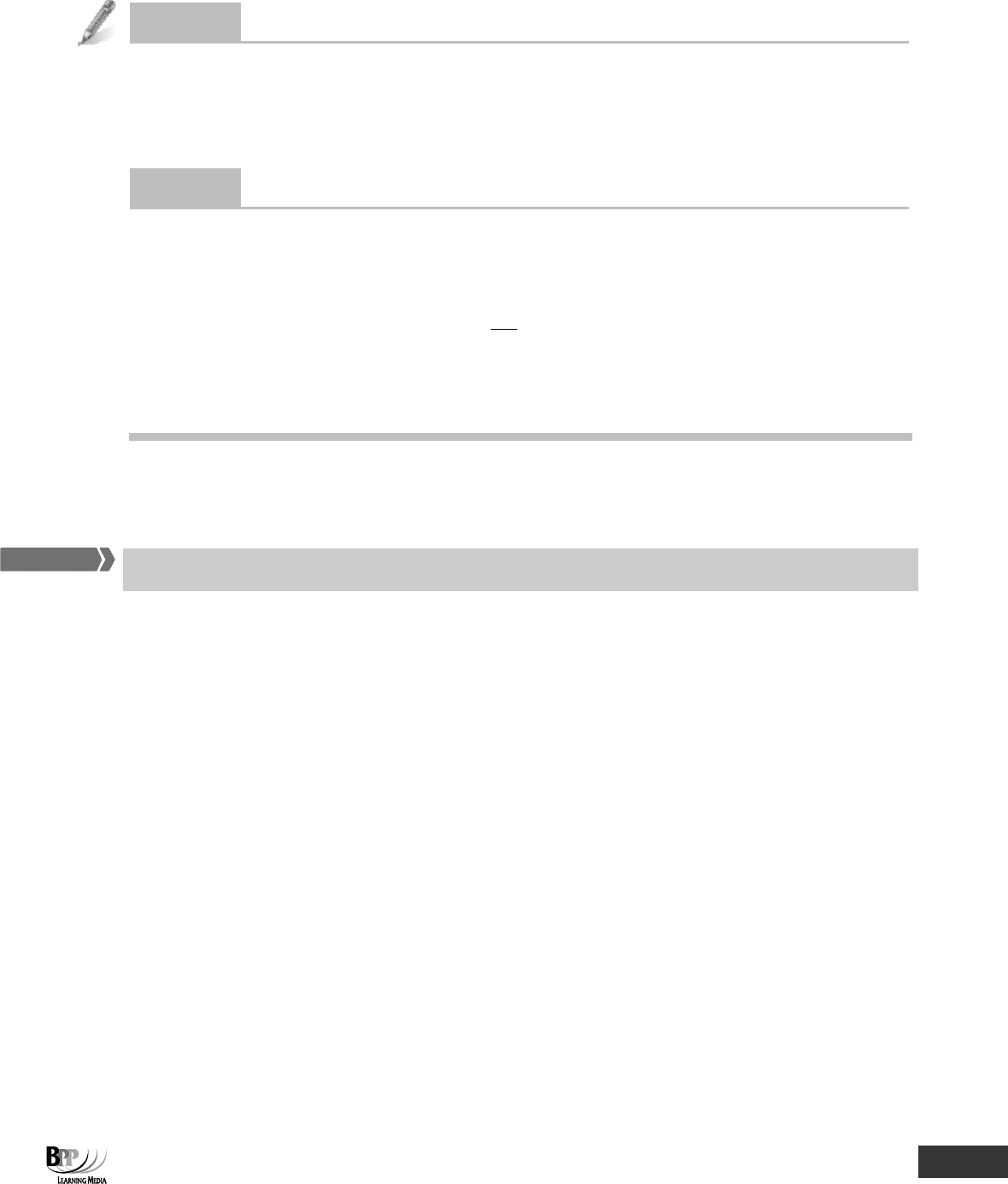
Part B Standard costing ⏐ 7: Standard costing
157
Question
Standard labour costs
A unit of product X requires 24 active labour hours for completion. It is anticipated that there will be 20% idle time which
is to be incorporated into the standard times for all products. If the wage rate is $10 per hour, what is the standard
labour cost of one unit of product X?
A $192 B $240 C $288 D $300
Answer
The correct answer is D.
The basic labour cost for 24 hours is $240. However with idle time it will be necessary to pay for more than 24 hours in
order to achieve 24 hours of actual work. Therefore options A and B are incorrect.
Standard labour cost = active hours for completion ×
100
125
× $10 = 24 × 1.25 × $10 = $300
Option C is incorrect because it results from simply adding an extra 20 per cent to the labour hours. However the idle
hours are 20 per cent of the total hours worked, therefore we need to add 25 per cent to the required active hours, as
shown in the working.
3 Other aspects of standard costing
There are a number of advantages and disadvantages of standard costing.
3.1 Problems in setting standards
(a) Deciding how to incorporate inflation into planned unit costs
(b) Agreeing on a performance standard (attainable or ideal)
(c) Deciding on the quality of materials to be used (a better quality of material will cost more, but perhaps
reduce material wastage)
(d) Estimating materials prices where seasonal price variations or bulk purchase discounts may be significant
(e) Finding sufficient time to construct accurate standards as standard setting can be a time-consuming
process
(f) Incurring the cost of setting up and maintaining a system for establishing standards
(g) Dealing with possible behavioural problems, managers responsible for the achievement of standards
possibly resisting the use of a standard costing control system for fear of being blamed for any adverse
variances
FA
S
T F
O
RWAR
D
178433 www.ebooks2000.blogspot.com
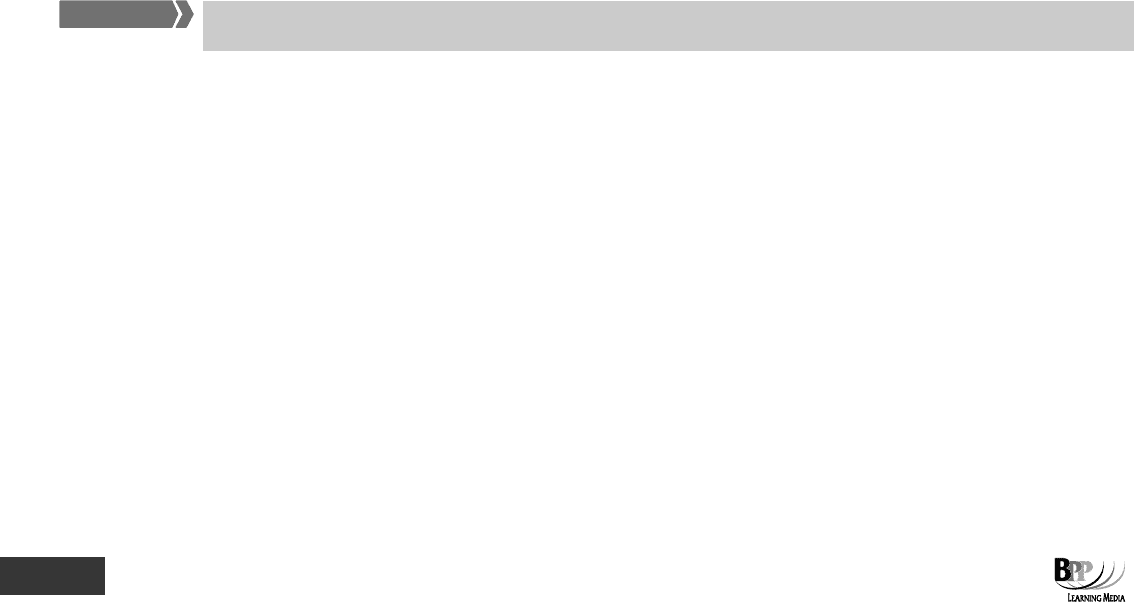
158
7: Standard costing ⏐ Part B Standard costing
3.1.1 Standard costing and inflation
Note that standard costing is most difficult in times of inflation but it is still worthwhile.
(a) Usage and efficiency variances will still be meaningful.
(b) Inflation is measurable: there is no reason why its effects cannot be removed from the variances
reported.
(c) Standard costs can be revised so long as this is not done too frequently.
3.2 The advantages of standard costing
(a) Carefully planned standards are an aid to more accurate budgeting.
(b) Standard costs provide a yardstick against which actual costs can be measured.
(c) The setting of standards involves determining the best materials and methods which may lead to cost
economies.
(d) A target of efficiency is set for employees to reach and cost consciousness is stimulated.
(e) Variances can be calculated which enable the principle of 'management by exception' to be operated.
Only the variances which exceed acceptable tolerance limits need to be investigated by management with a
view to control action.
(f) Standard costs simplify the process of bookkeeping in cost accounting, because they are easier to use
than LIFO, FIFO and weighted average costs.
(g) Standard times simplify the process of production scheduling.
(h) Standard performance levels might provide an incentive for individuals to achieve targets for themselves
at work.
3.3 The applicability of standard costing
Standard costing systems can be adapted to remain useful in the modern business environment.
3.3.1 Criticisms of standard costing
Critics of standard costing have argued that standard costing is not appropriate in the modern business environment.
(a) The use of standard costing relies on the existence of repetitive operations and relatively homogeneous
output. Nowadays many organisations are forced continually to respond to customers' changing
requirements, with the result that output and operations are not so repetitive.
(b) Standard costing systems were developed when the business environment was more stable and less
prone to change. The current business environment is more dynamic and it is not possible to assume
stable conditions.
(c) Standard costing systems assume that performance to standard is acceptable. Today's business
environment is more focused on continuous improvement.
(d) Standard costing was developed in an environment of predominantly mass production and repetitive
assembly work. It is not particularly useful in today's growing service sector of the economy.
FA
S
T F
O
RWAR
D
179433 www.ebooks2000.blogspot.com
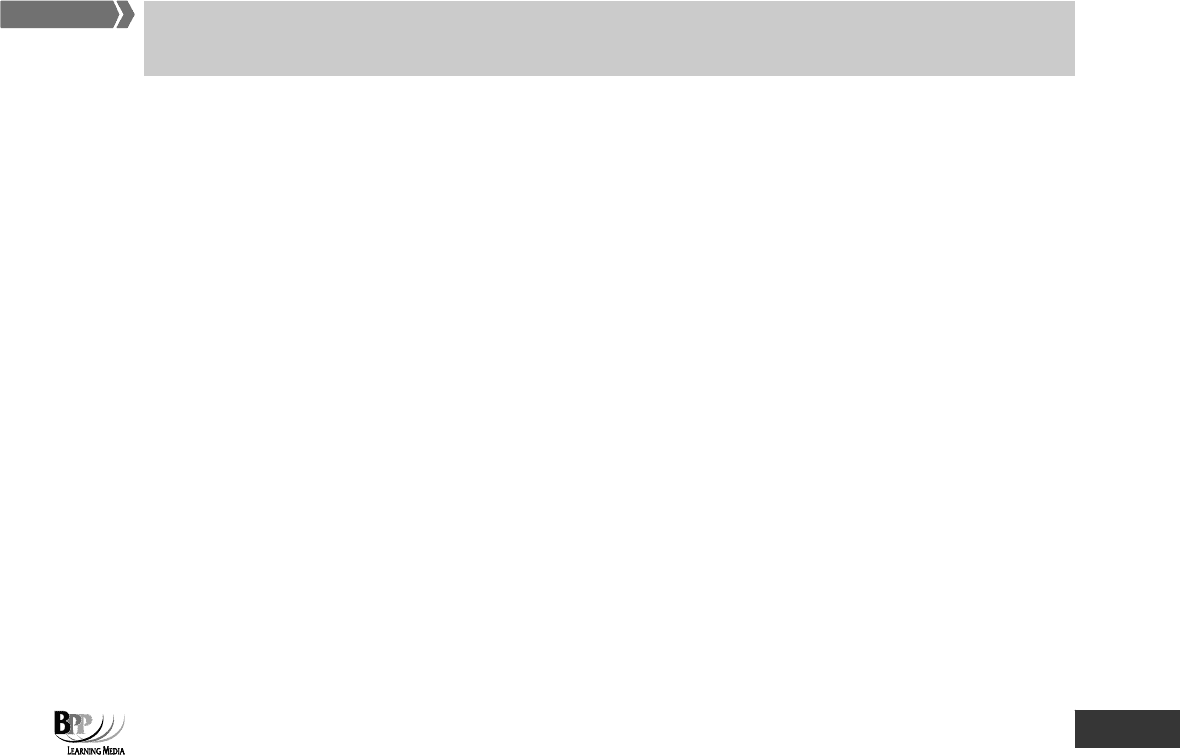
Part B Standard costing ⏐ 7: Standard costing
159
3.3.2 Using standard costing today
This long list of criticisms of standard costing may lead you to believe that such systems have little use in today's
business environment. However standard costing systems can be adapted to remain useful.
(a) Even when output is not standardised, it may be possible to identify a number of standard components
and activities whose costs may be controlled effectively by the setting of standard costs and identification
of variances.
(b) The use of computer power enables standards to be updated rapidly and more frequently, so that they
remain useful for the purposes of control by comparison.
(c) The use of ideal standards and more demanding performance levels can combine the benefits of
continuous improvement and standard costing control.
(d) Standard costing can be applied in service industries, where a measurable cost unit can be established.
For example it is possible to set a standard cost for the following.
• Transport cost per tonne-mile
• Laundry cost per hotel room night
• Cost per chargeable consultant hour
• Cost per equivalent full time student
• Cost per medical examination
4 The standard hour
The standard hour can be used to overcome the problem of how to measure output when a number of dissimilar
products are manufactured.
4.1 Example: standard hour
S Co manufactures plates, mugs and eggcups. Production during the first two quarters of 20X5 was as follows.
Quarter 1 Quarter 2
Plates 1,000 800
Mugs 1,200 1,500
Eggcups 800 900
The fact that 3,000 products were produced in quarter 1 and 3,200 in quarter 2 does not tell us anything about S Co's
performance over the two periods because plates, mugs and eggcups are so different. The fact that the production mix
has changed is not revealed by considering the total number of units produced. This is where the concept of the
standard hour is useful.
The standard hour (or standard minute) is the amount of work achievable, at standard efficiency levels, in an hour or
minute.
(a) The standard time allowed to produce one unit of each of S Co's products is as follows.
Standard time
Plate
1
/
2
hour
Mug
1
/
3
hour
Eggcup
1
/
4
hour
FAST FORWARD
180433 www.ebooks2000.blogspot.com
